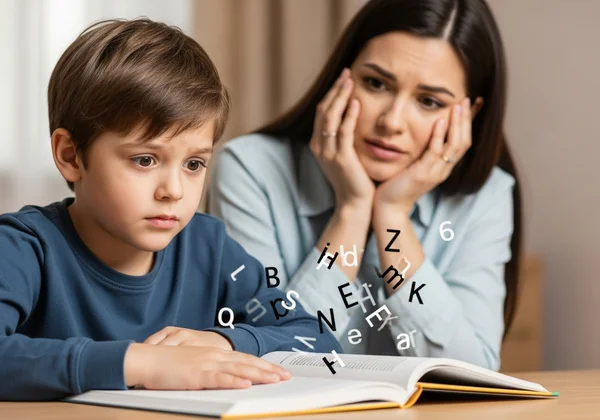Dyslexia Support & Screening: Home Strategies for Your Child's Reading Journey
It's natural to feel overwhelmed when you suspect your child is struggling with reading. As parents, you often wonder, how to help a child with dyslexia and what practical steps can be taken right in your home? This guide offers effective dyslexia strategies designed for parents to support their child's reading journey, fostering a positive learning environment. Taking the first step to understand your child's unique needs is crucial, and a great way to begin is by using a reliable screening tool. You can always take a free dyslexia screening test to gain initial insights.
Understanding Dyslexia: Recognizing the Signs & Your Role
Dyslexia is a common learning difference that primarily affects reading. It's neurological in origin, meaning the brain processes language differently, often impacting skills like decoding, spelling, and fluent reading. Understanding what it means for your child is the first step towards providing effective support.
What Dyslexia Means for Your Child's Learning Journey
For children with dyslexia, the traditional methods of learning to read and write can be more challenging. It doesn't reflect on their intelligence; many bright and creative individuals have dyslexia. Instead, it means they need specific, targeted teaching approaches that cater to their unique learning style. Your role as a parent is vital in providing consistent support, advocating for their needs, and celebrating their progress, no matter how small.
Common Indicators of Reading Difficulties in Children
Identifying the signs early can make a significant difference. While every child is different, common signs of dyslexia might include difficulty with rhyming, learning the alphabet, or sounding out words. For instance, if you observe signs of dyslexia in a 7-year-old, such as struggling to read common words, mixing up letters like 'b' and 'd', or finding reading tiresome, these could be indicators. It's important to remember that these are just signs, and only a professional screening or assessment can provide further clarity. To get a preliminary understanding of potential indicators, consider a free online dyslexia test.

Essential Reading Support Strategies at Home
Providing reading support at home involves creating engaging and structured learning opportunities. These strategies focus on foundational skills crucial for developing literacy.
Cultivating Phonological Awareness with Fun Activities
Phonological awareness is the ability to recognize and manipulate the sound structure of spoken language, a cornerstone of reading. Engage your child in playful activities that build this skill:
-
Rhyming Games: Play "What rhymes with cat?" or sing rhyming songs.
-
Syllable Clapping: Clap out the syllables in words (e.g., "but-ter-fly" has three claps).
-
Sound Isolation: Ask your child to identify the beginning, middle, or ending sound in a word (e.g., "What's the first sound in 'dog'?").
-
Sound Blending: Say individual sounds and have your child blend them into a word (e.g., "/c/-/a/-/t/" makes "cat"). These activities can be done anywhere, making learning enjoyable and less like "schoolwork."

Building Decoding & Fluency Skills through Multisensory Play
Decoding is the ability to sound out words, while fluency is reading accurately, quickly, and with expression. Multisensory approaches engage multiple senses (sight, sound, touch, movement) to help children learn.
- Letter Tracing: Have your child trace letters in sand, shaving cream, or glitter glue while saying the letter sound. This kinesthetic approach helps cement letter-sound connections.
- Tactile Letter Cards: Create or buy letter cards with textured materials like sandpaper. Your child can trace the letter while saying its sound.
- Reading Aloud Together: Read books aloud with your child, taking turns reading paragraphs or pages. Model fluent reading and provide gentle corrections.
- Echo Reading: You read a sentence or phrase, and your child "echoes" it back. This builds fluency and expression.
- Repeated Reading: Choose a short, interesting passage and have your child read it several times until they can read it smoothly. Consistent practice with these strategies can significantly improve your child's reading abilities.
Tackling Writing & Spelling Challenges with Home Learning Tips
Dyslexia often impacts writing and spelling alongside reading. Fortunately, many home learning tips can help alleviate these difficulties.
Practical Approaches for Improving Spelling Accuracy
Spelling can be particularly frustrating for children with dyslexia due to challenges with phonics and memory.
-
Look, Say, Cover, Write, Check (LSCWC): A classic and effective method. Your child looks at a word, says it aloud, covers it, writes it from memory, and then checks if it's correct.
-
Segmenting Sounds: Encourage your child to break words into individual sounds (e.g., "cat" into /c/, /a/, /t/) before writing them.
-
Use Visuals: For tricky words, create visual cues or mnemonic devices. For example, the word "friend" could be remembered as "Fry an Incredibly Enormous New Doughnut."
-
Spelling Rules Fun: Turn common spelling rules (like "i before e except after c") into games or jingles.
-
Word Families: Work on word families (e.g., -at words like cat, hat, mat) to recognize patterns.

Simple Strategies to Make Writing Less Overwhelming
Writing can feel like a monumental task when combining spelling, grammar, and idea generation.
- Scribe for Them: Sometimes, the best way to encourage ideas is to act as a scribe. Let your child dictate their thoughts, stories, or sentences while you write them down. This removes the mechanical burden and allows them to focus on expression.
- Graphic Organizers: Use simple graphic organizers (like mind maps or storyboards) to help them plan and structure their thoughts before writing.
- Focus on Ideas First: Encourage them to get their ideas down without worrying about perfect spelling or grammar initially. Edits can come later.
- Sentence Starters: Provide sentence starters or simple templates to help them begin writing.
- Typing over Handwriting: For some children, typing can be less daunting than handwriting, as it reduces the motor skills demand and avoids issues like letter reversals. These strategies can make writing a more accessible and enjoyable activity.
Creating a Positive & Empowering Home Environment
Beyond specific academic strategies, a supportive and understanding home environment is paramount when parenting dyslexia. It builds resilience and self-esteem.
Encouraging a Growth Mindset and Celebrating Small Wins
A growth mindset teaches children that their abilities can be developed through dedication and hard work. It's vital for children with dyslexia to understand that their struggles are not a reflection of their intelligence.
-
Praise Effort, Not Just Outcome: Instead of saying "You're so smart," say "I'm proud of how hard you worked on that difficult word."
-
Normalize Mistakes: Explain that mistakes are opportunities to learn and grow.
-
Set Achievable Goals: Break down large tasks into smaller, manageable steps, and celebrate the completion of each step.
-
Focus on Strengths: Help your child identify and develop their unique strengths, whether in art, sports, music, or problem-solving. Dyslexic individuals often excel in areas like creativity, visual thinking, and entrepreneurship.

Collaborating with Educators for Comprehensive Support
Your child's school is a key partner in their educational journey. Effective collaboration is essential for holistic dyslexia support.
- Share Information: Inform your child's teacher about your observations and any screening results.
- Discuss Strategies: Ask what dyslexia strategies the school uses and how you can reinforce them at home.
- Advocate for Needs: Work with the school to ensure your child receives appropriate accommodations and interventions. Don't hesitate to talk to teacher dyslexia concerns openly and constructively.
- Regular Check-ins: Schedule regular meetings with teachers and support staff to discuss your child's progress and adjust strategies as needed.
Ready to Support Your Child's Reading Journey? Next Steps!
Supporting a child with dyslexia is a journey that requires patience, understanding, and consistent effort. By implementing these home strategies and fostering a nurturing environment, you can significantly empower your child to overcome reading challenges and unlock their full potential. Remember, early identification is a powerful tool in this process. If you suspect your child might have dyslexia, taking a preliminary step can provide valuable insights.
Take the first step today towards understanding your child's unique learning profile. Start the dyslexia test now to receive an immediate report and personalized suggestions that can guide your next steps. Our free, confidential online screening tool is designed by experts to offer an initial assessment of reading and language processing skills.
Your Questions Answered: FAQs for Parents Supporting Children with Dyslexia
What are the early signs of dyslexia in young children?
Early signs of dyslexia in young children often include difficulty recognizing letters, struggling to learn and remember the alphabet, trouble with rhyming, mispronouncing familiar words, or a family history of reading difficulties. Observing these common indicators of reading difficulties can be the first step. For a quick assessment, you can utilize an online dyslexia test designed for early screening.
How accurate is an online dyslexia screening test?
An online dyslexia test like the one offered on this platform is a highly effective screening tool designed to identify potential risks and highlight areas of concern, but it is not a diagnostic tool. It helps parents and individuals understand if there's a strong likelihood of dyslexia, guiding them on whether to seek a formal, professional diagnosis. It is a valuable starting point for dyslexia screening.
Besides home strategies, what other support can my child receive?
Beyond home learning tips, your child can receive support through school-based interventions (such as special education services or individualized education programs), tutoring by specialists in structured literacy approaches (like Orton-Gillingham), and assistive technology (e.g., text-to-speech software). Discussing your child's needs with educators and seeking professional assessments is crucial for comprehensive dyslexia support.
Does dyslexia get better over time, or can it be cured?
Dyslexia is a lifelong learning difference and cannot be "cured." However, with appropriate and consistent dyslexia strategies and interventions, individuals with dyslexia can significantly improve their reading and writing skills, often becoming fluent and successful readers and writers. Early identification and sustained support are key to managing its challenges and maximizing a child's potential. Begin understanding with a free dyslexia test today.